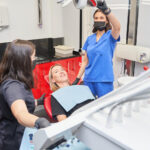Anti-acne patches have gained popularity as a quick and effective way to combat pimples. They work by creating a barrier on the skin, which helps to reduce inflammation and prevent picking at blemishes. These patches can deliver results in just a few hours, making them an essential tool for anyone dealing with breakouts. With various options available, choosing the right patch can make a noticeable difference in the treatment of acne.
Understanding how these patches function is key to their effectiveness. They typically contain active ingredients like salicylic acid or tea tree oil that target the root causes of acne. By applying these patches directly to the affected area, individuals can expedite the healing process without harsh treatments or medications.
For best results, knowing how to use these patches correctly is crucial. Each patch should be applied to clean, dry skin and left on for the recommended time. This simple method can lead to clearer skin and increased confidence, making it easier to manage breakouts.
Key Takeaways
- Anti-acne patches provide a quick solution for treating pimples.
- Active ingredients in the patches help reduce inflammation and prevent picking.
- Proper application is essential for achieving the best results.
Understanding Acne and Its Causes
Acne is a common skin condition that can affect anyone at any age. It is important to recognize the various types of acne, the causes behind them, and the significance of treating this condition for better skin health.
Types of Acne
There are several types of acne, each with specific characteristics. The most common types include:
- Whiteheads: Closed clogged pores that appear white on the surface.
- Blackheads: Open clogged pores that appear dark due to oxidation.
- Papules: Small, raised red bumps that may be sensitive to touch.
- Pustules: Similar to papules, but filled with pus and often appear white or yellow.
- Nodules: Large, painful lumps beneath the surface of the skin.
- Cysts: Deep, painful, pus-filled lumps that can cause scarring.
Recognizing these types can help individuals seek proper treatment and care.
Common Causes of Acne
Acne develops when hair follicles become clogged with oil and dead skin cells. Several factors lead to this condition:
- Excess Oil Production: The sebaceous glands produce too much sebum, leading to clogged pores.
- Hormonal Changes: Increased levels of hormones, especially androgens, can trigger oil production. This is common during puberty.
- Bacteria: The presence of Propionibacterium acnes bacteria can worsen inflammation.
- Diet: Certain foods, particularly high in sugar or dairy, may affect acne for some people.
- Medications: Some drugs, such as corticosteroids or lithium, can also contribute to acne.
Understanding these causes is essential in managing and preventing acne.
Why Acne Treatment Is Important
Treating acne is crucial for several reasons. First, it helps prevent scarring, which can lead to long-term skin damage. Effective treatment can improve self-esteem and reduce emotional distress linked to visible acne.
Additionally, controlling acne can prevent the progression to more severe forms. Treatments, including anti-acne patches, help reduce inflammation and eliminate bacteria. Prompt treatment can also address issues early, leading to better outcomes.
Recognizing the need for immediate care can significantly impact a person’s overall skin health and confidence.
What Are Anti-Acne Patches?
Anti-acne pimple patches are specialized skincare products designed to treat and reduce pimples effectively. These patches offer a convenient and targeted way to help clear breakouts without aggressive treatments.
Composition of Anti-Acne Patches
Anti-acne patches are usually made from hydrocolloid material. This type of material helps absorb excess oil and pus from the pimple, which can speed up healing.
Many patches also contain beneficial ingredients such as salicylic acid, benzoyl peroxide, or tea tree oil. These ingredients are known for their acne-fighting properties.
The patches create a moist environment around the pimple, which may help prevent scarring. Some varieties even feature microdarts that deliver active ingredients deeper into the skin, targeting cystic acne effectively.
Types of Anti-Acne Patches
There are several types of anti-acne patches available, each designed for specific needs.
- Hydrocolloid Patches: These are the most common and work well for whiteheads and pimples. They are known for their ability to absorb fluid.
- Microdart Patches: These patches contain tiny needles that dissolve under the skin. They are effective for deeper cystic acne.
- Medicated Patches: Some patches contain active ingredients like salicylic acid or retinol. They treat and help reduce inflammation.
Choosing the right type depends on the specific acne condition. Reading product labels can help identify which patch best suits individual needs.
How Do Anti-Acne Patches Work?
Anti-acne patches are specialized products designed to target pimples directly. They create a moist environment that aids healing while absorbing excess fluids. These patches often contain various active ingredients that help reduce inflammation and prevent further acne development.
Active Ingredients in Patches
Many anti-acne patches contain hydrocolloid, which is key to their function. Hydrocolloid absorbs fluid from the pimple, helping to reduce swelling and redness. It forms a barrier, protecting the area from bacteria and dirt.
Other common ingredients may include:
- Salicylic Acid: A beta hydroxy acid that helps unclog pores.
- Tea Tree Oil: Known for its antibacterial properties.
- Benzoyl Peroxide: Targets acne-causing bacteria.
These ingredients work together to speed up healing and prevent new breakouts.
Patch Application and Skin Interaction
Applying anti-acne patches is simple. First, the area should be clean and dry. The patch is then placed directly over the pimple. Once applied, it adheres to the skin, providing a protective barrier.
As the patch sits, it interacts with the skin’s moisture. This helps draw out impurities while keeping the area moist. The patch can usually remain for several hours or overnight, providing continuous treatment. Users should follow specific instructions for the best results, such as not reusing patches.
Benefits of Using Anti-Acne Patches
Anti-acne patches offer targeted treatment for various types of acne. They can accelerate healing and provide a convenient way to tackle breakouts with minimal effort.
Effectiveness for Different Acne Types
Anti-acne patches are especially effective for certain types of acne, such as whiteheads and preventable pimples. The patches typically use hydrocolloid technology, which absorbs excess fluid and helps reduce inflammation.
Some patches are infused with ingredients like tea tree oil or salicylic acid. These ingredients can target bacteria and support the skin’s healing process. This dual-action makes patches suitable for different acne scenarios.
For closed lesions or deep cystic acne, patches may not be effective. They work best on those visible bumps that are ready to be addressed. Users should choose the right type based on their acne stage for optimal results.
Advantages Over Other Treatments
Anti-acne patches offer several advantages compared to traditional treatments. First, they are easy to use and can be worn overnight or during the day.
They provide instant coverage, reducing the urge to touch or pick at pimples. This helps prevent further irritation and scarring.
Unlike creams or gels, patches deliver a concentrated dose of treatment directly to the affected area. This targeted approach can enhance effectiveness while minimizing side effects.
Additionally, many patches are designed to be discreet, allowing users to maintain their daily routines without drawing attention to their acne. This combination of convenience and effectiveness makes anti-acne patches a popular choice for managing breakouts.
How to Use Anti-Acne Patches for Best Results
To achieve the best results with anti-acne patches, it’s crucial to prepare the skin properly and apply the patches correctly. Following these steps can help maximize effectiveness and speed up healing.
Preparing Your Skin
Before applying an anti-acne patch, it is essential to ensure that the skin is clean. Start by washing the affected area with a gentle cleanser. This removes dirt, oil, and bacteria that could interfere with the patch’s effectiveness.
After cleansing, pat the skin dry with a clean towel. Avoid rubbing, as this can irritate the skin. If needed, apply a toner to further cleanse and balance the skin’s pH.
It’s also recommended to use a mild exfoliant, but not right before patch application. This helps clear away dead skin cells without causing sensitivity. Taking these steps helps the patch stick better and absorb infection more effectively.
Application Tips
For effective application, first ensure hands are clean. Wash them with soap and water to prevent transferring bacteria to the pimple.
Carefully remove the anti-acne patch from its packaging. Place the patch directly over the blemish. Press gently around the edges to ensure a good seal.
It’s best to leave the patch on for at least six hours, or as directed on the packaging. This duration allows the active ingredients to work effectively.
For optimal results, avoid using heavy creams or makeup over the patch. These can prevent it from adhering well and may block the ingredients from doing their job. Change patches as instructed, especially if they become discolored or lose adhesion.














